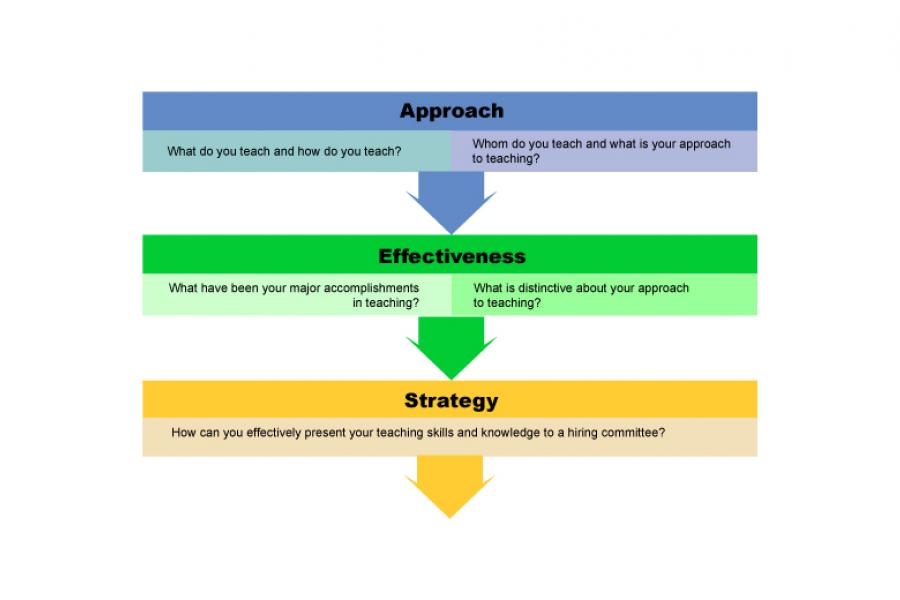Teaching dossier
A teaching dossier is a document that contains carefully selected and assembled materials and representative artifacts of one’s achievements in teaching.

Introduction
A teaching dossier is a reflection of one’s beliefs, preparation, thoughtfulness and innovation in teaching. A teaching dossier is often required in applications for university positions and for tenure and promotion. Teaching dossiers require only a representative sampling of evidence. Select pieces of evidence from your records that effectively convey your teaching innovations and course materials.
Why Prepare a Teaching Dossier?
- To document teaching effectiveness
- To reflect on teaching philosophies
- An occasion to assess one’s practices, to question one’s methods, and to plan for the future
- As a formative tool to improve teaching strategies
- As a supplement to the curricula vitae
Teacher dossier format
- Narrative framework:
- Teaching Philosophy Statement
- Narrative descriptions of teaching experiences
- Critical reflection
- Artifacts:
- Supporting evidence( with brief explanatory notes)
| – Statement of Teaching Philosophy – Explanation of Teaching Goals |
– 2 pages single-spaced – First person |
|---|---|
| Summary of Teaching Experience – includes course descriptions; course development; innovation and responsibilities | 3-4 pagesTables and Narrative & supporting appendices |
| Efforts to improve Teaching: reflections, evaluations, programs, workshops attended | 3-4 pagesTables and Narrative |
| Student Advising | 1 page (tables) |
| Information from students and colleagues: SEEQ results and reflections, letters of support | 3-4 pages |
| Service to Teaching | 1 page |
| Future Teaching Goals | Half to 1 page |
| Supporting documentation Appendices with narrative introductions |
1 page |
The reflective process of developing a teaching dossier
- Collecting and sorting through items for a dossier starts with individuals thinking about their experiences, what has worked for them, what has not (self-assessment) and what to try next (goal-setting)
- The act of constructing and organizing the dossier is a reflective process.
The how and what of the reflective process

Approach
What do you teach and how do you teach?
Whom do you teach and what is your approach to teaching?
Effectiveness
What have been your major accomplishments in teaching?
What is distinctive about your approach to teaching?
Strategy
How can you effectively present your teaching skills and knowledge to a hiring committee?
How do I create a teaching dossier?
Clarify Teaching Responsibilities
Start with an understanding of your teaching identity as articulated in your teaching statement (also called teaching philosophy) and the role that you are expected to play in the jobs you are applying to. This will help you determine what kinds of specifics need to be documented.
Select Items for Your Dossier
Select artifacts that reflect your teaching identity as articulated in your teaching statement and are relevant to expected teaching responsibilities rather than gathering every piece of data that can be found.
Prepare Statements on Each Item
Prepare statements on each item that shows its relation to your teaching identity and expected responsibilities.
Arrange the Items in Order
The order might be in terms of importance to your responsibilities or chronological to show growth over time. The order can also be by categories of teaching responsibilities to show breadth.
Compile the Supporting Data
Evidence relating to the statements on each item should be gathered to support conclusions drawn. This evidence is best placed in an appendix.
Selecting items to include in your teaching dossier
It is especially important to note that for tenure and promotion, committee members may expect to see certain pieces of evidence. It is important to identify these and ensure that they are well-represented in your teaching dossier.
- Students’ evaluations
- List of courses
- List of materials and how they are used
- Participation in workshops
- Observations from colleagues
- Attempts at innovations (and the results)
- Letters from students
- Curriculum development (including new courses you have proposed)
- Supervision of honours, masters, and doctoral students
- Tests, exercises, etc., and teaching techniques
Other Materials Included in Teaching Dossiers
There is a broad range of other materials that can also be included in your teaching dossier, and although the list presented here is fairly extensive, there are probably many ideas that it does not cover. It is important to include materials that reflect your teaching, and those materials may include sources that are not covered here.
- Record of changes made in teaching, and results
- Statement of teaching plans and goals for the future
- Evidence to illustrate your teaching methods (such as discussion groups, critical thinking, technologies, fieldwork, and students’ projects)
- Personal evaluation of teaching
- Research concerning teaching
- Awards and recognition of teaching
- Information about student interaction, advising, and availability
- Service to committees focused upon teaching
- Funding for teaching-related projects
- Invitations to present papers on teaching your discipline (or presentations to outside agencies)
- Role in faculty development, such as mentoring new faculty or facilitating
- Teaching workshops
- A video of your teaching
Curate of Teaching Portfolio. The University of Texas at Austin: Faculty of Innovation Center.
Sample teaching dossiers
While the samples below do not follow all of the dossier guidelines detailed above, they may act as valuable exemplars of dossier organization, structure and content.
Sample Teaching Dossiers from the Western Teaching Support Centre
Laura Kerr (Faculty member, Queen’s University, 2007) Excellent Teaching Responsibilities, Teaching Innovations, and Evidence of Teaching Effectiveness sections.
Andreas Glombitza (Faculty member, Universität Tübingen, 2012) Excellent Philosophy Statement and Teaching Goals & Strategies section
Source: Teaching Portfolio. (n.d.). Western Teaching Support Centre.
Sample Dossiers from Queen’s University
Brian Frank (PDF, 378KB)
Elizabeth Sled (PDF, 68KB)
Andrea Phillipson (PDF, 522KB)
Sonja Martina Allen (PDF, 616KB)
Source: Teaching Dossiers. (n.d.). Queen’s University: Center for Teaching and Learning. Retrieved from http://www.queensu.ca/ctl/teaching-support/teaching-dossier
Online Dossiers (selected by Western University)
Maged Senbel (Urban Design and Architecture)
Isaac A. Kamola (Political Science)
Source: Creating a Teaching Dossier: Workshop Resources. (n.d.). Lakehead University: Teaching Commons.
Final tips
- Develop a system of filing and record-keeping that eases the collection of teaching materials, evaluations, and evidence
- Tailor your dossier specifically to reflect your teaching
- Find out how the tenure and promotion process works in your department; what are the specific teaching dossier requirements in your faculty or department – some faculties have a detailed list of requirements
- Talk to faculty both in and outside of your department to learn what they do in preparation for tenure and promotion review.
- When your teaching dossier comes up for review by your departmental tenure and promotion committee, submit a letter to highlight and draw attention to particular aspects of your teaching
- Present your teaching dossier in a neat, organized manner that is easily accessible by the reader/reviewer; most faculties are still requiring paper-based dossiers, but some departments prefer an e-version of the dossier
- The most daunting requirement of a teaching dossier is the development of the statement of teaching philosophy; even if you are not aware of your teaching philosophy, it forms an integral part of your teaching activities
Resources and references
Online Resources
Teaching Dossier (Canadian Association of University Teachers) – pdf
Teaching Dossier (Queen’s University)
Teaching Dossier Guide (University of Toronto)
Teaching Portfolios (UBC)
Text Resources
Brookfield, Stephen. (2017). Becoming a Critically Reflective Teacher. San Francisco:Jossey-Bass.
Documentation: CTLT Resources/Selected TL Topics Portfolios. (n.d.). In UBC Wiki.
Knapper, C. & Wilcox, S. (2007). Preparing a Teaching Dossier. Kingston: Queen’s University, Centre for Teaching & Learning.
Lewis, K.G. (2001). Using midsemester student feedback and responding to it. New Directions for Teaching and Learning 87, pp. 33-44.
O’Neal, C., & Wright, A. (1993). Recording teaching accomplishment: A Dalhousie guide to the teaching dossier. Halifax: Dalhousie University, Office of Instructional Development and Technology.
Seldin, P. (Ed.). (1999) Changing practices in evaluating teaching. Bolton, MA: Anker.
Seldin, P. (2004). The teaching portfolio: A practical guide to improved performance and promotion/tenure decisions. 3rd edition, Bolton, MA: Anker.
Van Note Chism, N. (1997-98). “Developing a Philosophy of Teaching Statement.” Essays on Teaching Excellence 9:3: POD.
Zayani, M. (2001). The teaching portfolio: Toward an alternative outcomes assessment. Research and Teaching in Developmental Education, 18(1), 58–64.
